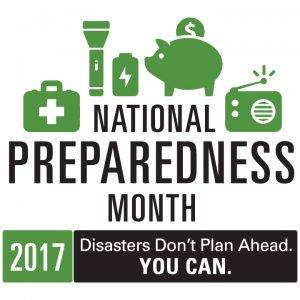Posted by: TAZ Networks on September 22, 2017 at 1:40 pm
September has been… wow.
Major hurricanes, major earthquakes, wildfires – it seems like, you name it, September in North America has had it. Fortunately, here in Michigan, we’ve only had some near-drought conditions and a few heat advisory days. (Pumpkin-spice latte on the rocks, anyone?)
Our hearts go out to those directly affected by these natural disasters. September’s events have definitively underscored the need to know what could possibly come your way and be prepared as possible to deal with it.
While your family and local community should be first priority for disaster readiness, this is obviously a business IT blog. So, what kind of emergency plan should your business have in place?
Ready.gov has an entire business-focused section for preparedness planning. It thoroughly covers every aspect: program management, planning, implementation, testing, and improvement.
The Implementation section includes a link for an information technology plan, which they recommend developing at the same time as your general business continuity plan.
With IT, it’s important to remember that natural disasters are not your only risks. Business owners and managers must also address physical theft, hacking, malware, and everyday issues like hardware failure and human error.
TAZ Networks can help set up your IT disaster recovery plan. Here are some of items Ready.gov recommends that we can assist with:
Hardware management. Need to know how many computers and servers you have? We securely document that information for our clients.
Software management. Licensing and cloud-based applications are more secure and easier to replace or reinstall than hard media such as CDs, etc.
Backups. Data loss and corruption cause major business disruptions – and sometime business closure. Backups must be scheduled and validated, and periodic test restores performed.
Data recovery. What’s your “recovery time objective”? In other words, how long can your company afford to be down? This measure will help determine the best solution for your backup and data restoration setup. Our clients have three main options for backup and disaster recovery:
- USB hard drives. This solution, while inexpensive, suffers from limitations common to all physical media: it can be lost, stolen, or destroyed. Data reliability depends on staff physically switching out drives on a regular, pre-determined time frame. While we support this solution, it is not our preference.
- Cloud backup. Cloud backup is flexible and reliable. Business size is not as important of a factor as having a reliable internet connection. Restoration can begin as soon as compatible hardware is available.
- Standby Server can bring data back online very quickly, often under an hour. It is specifically designed as a failover solution, with options for replicated backups locally as well as off-site.
One of our business associates suffered a direct hit from Hurricane Irma. From his first-hand experience, he proclaims, “There is more to business continuity than backing up data.”
Planning ahead for disasters can be the difference between going out of business and running a successful one. Develop a preparedness program for your business to plan for and reduce the impact of disasters.
